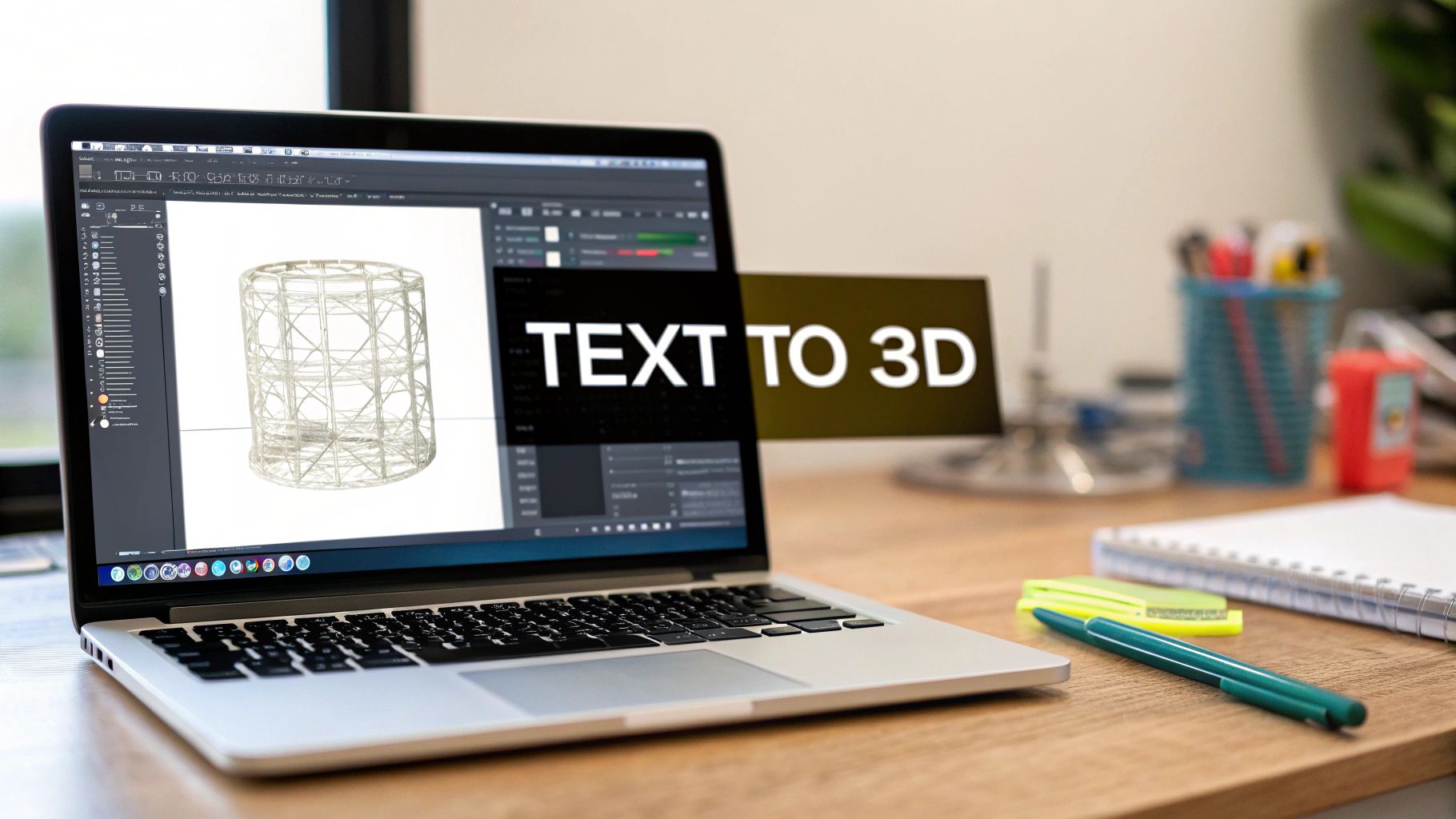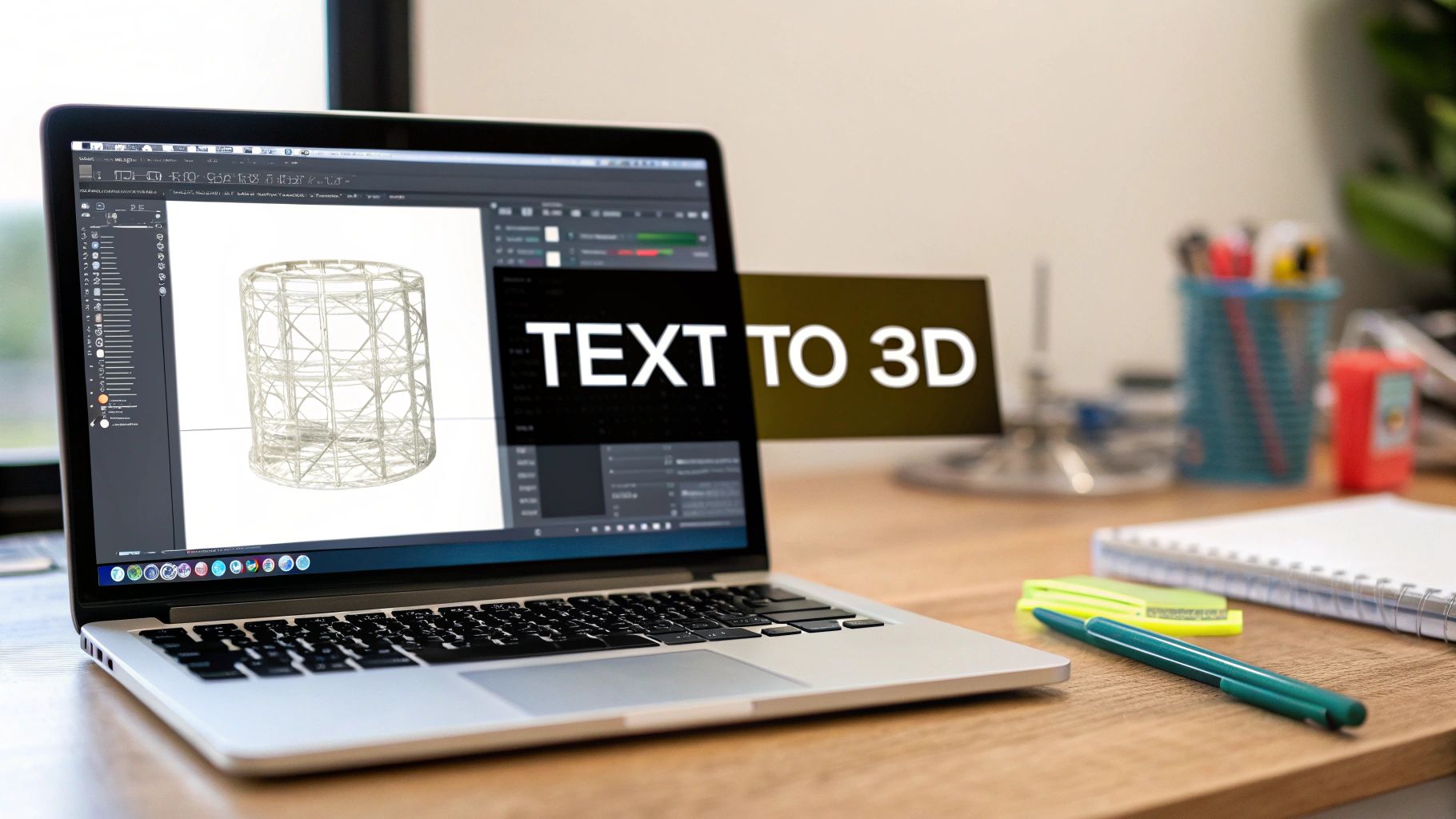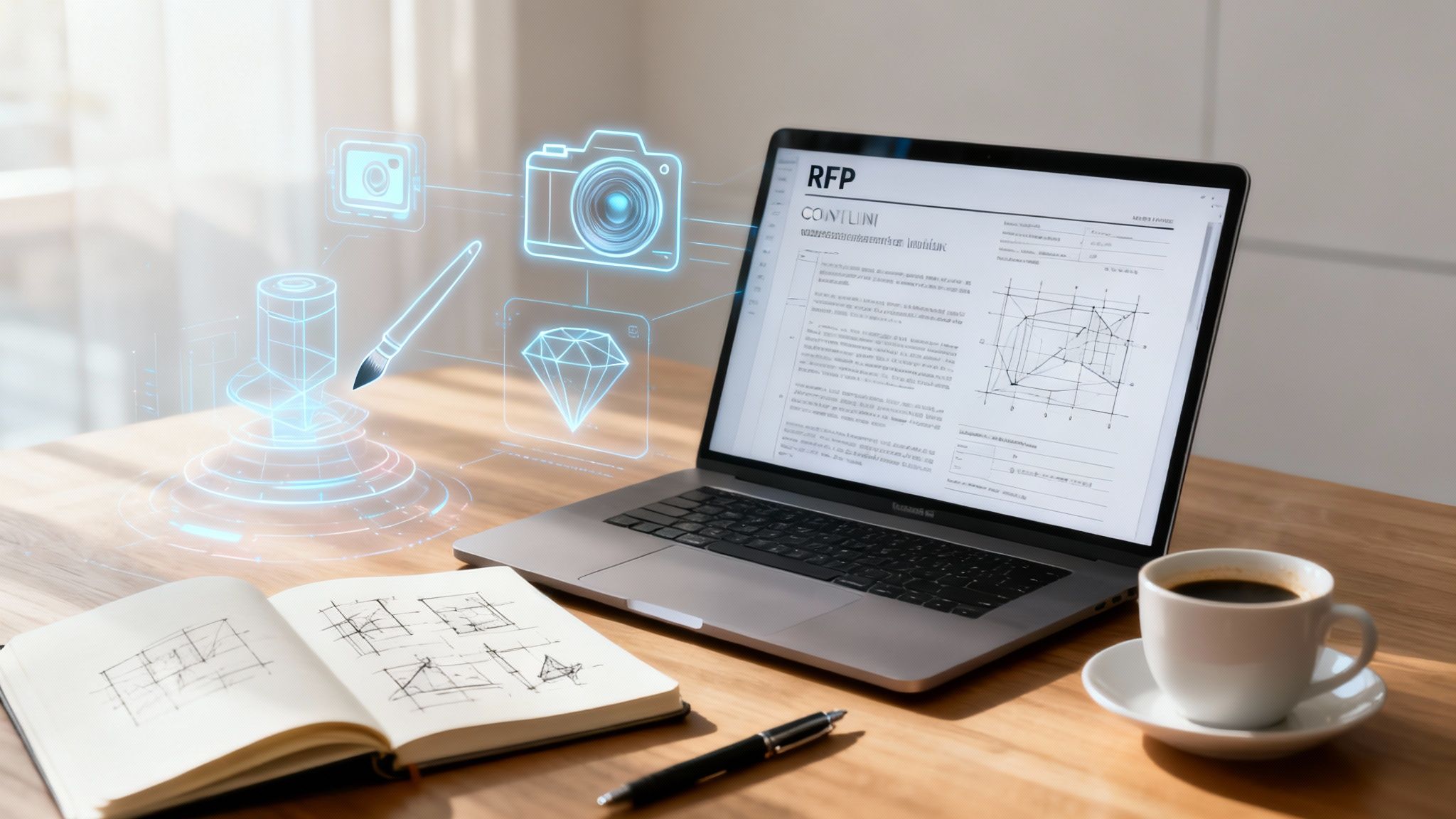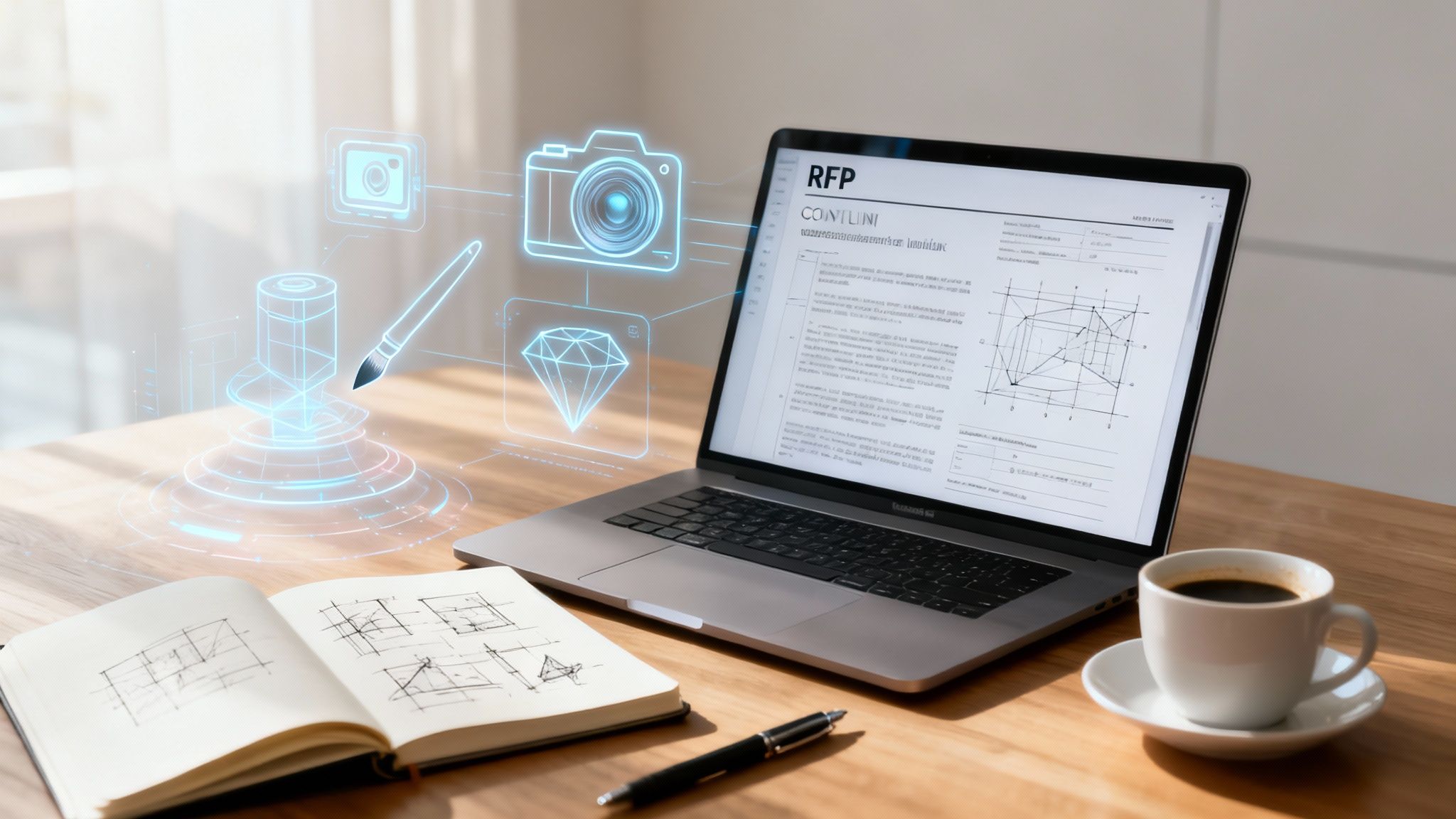What if you could create a product prototype simply by describing it?
That is the emerging reality of text-to-3D technology. It is a process that translates a written prompt into a detailed, three-dimensional digital asset. This is no longer a speculative concept; it is a practical tool for business innovation.
The Next Dimension of Enterprise Creativity
The power to instantly visualize an idea was once the exclusive domain of specialized 3D artists. That is changing. By turning simple text into tangible models, this technology builds a direct bridge between imagination and creation.
This is more than an interesting feature. It is a serious business tool that can accelerate workflows and enable broader innovation when implemented responsibly.
To fully appreciate the significance of this shift, it is helpful to have a broader understanding of AI tools and how they are already reshaping different industries.
A New Era of Content Production
For businesses, this technology unlocks a new level of efficiency and scale. Consider the practical applications:
- Rapid Prototyping: Instead of allocating days to manual modeling, product teams can generate and iterate on concepts in minutes. This allows for the sharing of tangible visuals with stakeholders without starting from scratch for every minor adjustment.
- Marketing and E-commerce: Marketers can create custom 3D visuals for a campaign or generate product models for augmented reality (AR) shopping experiences, streamlining content pipelines.
- Entertainment and Gaming: Studios can populate virtual worlds with props and environmental elements, allowing artists to focus on complex, character-driven work that requires a human touch.
This advancement is built on decades of AI development. While core concepts date back to the 1950s, the emergence of large language models (LLMs) in the 2020s made this technology feasible. AI learned to connect text with complex visual outputs, moving from text-to-image to full text-to-3D synthesis. You can explore the complete history of AI from TechTarget.
The primary benefit lies in integrating these tools into existing creative pipelines. It allows non-technical teams to contribute directly to the visualization process, breaking down a silo that previously impeded innovation. This guide will walk you through how to adopt this technology safely and effectively.
Selecting An Enterprise-Ready AI Modeling Platform
When a business evaluates text to 3d model generators, the initial demonstrations are only the beginning. For any serious enterprise application, the conversation must shift to security, compliance, and how the tool integrates with your team's established workflows. A platform must be a reliable partner, not just a novel technology.
First, you must look beyond surface-level features. A genuinely enterprise-ready platform will offer robust data privacy controls to ensure your proprietary prompts and the assets you generate remain confidential. It is also absolutely critical to scrutinize the commercial licensing terms. You must be certain you have unrestricted rights to use these models in your products and marketing campaigns.
Understanding Key Technical Differences
Not all 3D models are created equal, and the underlying technology significantly impacts their application. Your selection should be based entirely on the model's intended use case.
- Mesh-Based Models: This is the industry standard. These are digital structures built from vertices, edges, and faces. They are ideal for any asset that requires further editing, animation, or integration into game engines like Unreal or Unity.
- Volumetric Models (like Gaussian Splats): This newer format excels at creating photorealistic, static scenes with impressive detail. They are well-suited for high-end e-commerce product shots or virtual staging but can be difficult to edit with traditional 3D software.
If you wish to delve deeper into different modeling types, our 3D modeling software comparison is a valuable resource.
This distinction is crucial. A gaming studio, for instance, will almost always require mesh-based outputs for its character assets. Conversely, an architectural firm might favor the realism of a volumetric model for a client presentation.
A significant development in this space came from Adobe Research, which announced a dual-pipeline approach for its text to 3d model feature. Their system can generate both photorealistic Gaussian Splat models and traditional mesh models from the same text prompt, offering flexibility for different industries. You can read more about this innovation in Adobe's research announcement.
This image from Adobe shows 3D models generated from simple prompts like "a worn leather armchair."
It is a strong example of how these platforms can interpret descriptive language and convert it into the detailed textures and shapes required for professional work.
To help businesses navigate these choices, we've compiled a comparison of what to look for when evaluating different text-to-3D platforms for enterprise deployment.
Comparing Text-to-3D Generator Features for Enterprise Use
This table highlights that the "best" platform depends on your company's specific requirements—whether that's creating editable game assets, photorealistic marketing visuals, or another application.
Vetting Platforms For Business Integration
Finally, practical integration is a non-negotiable requirement for any serious business adoption. The right platform must have a well-documented API. This enables your development team to build custom workflows or integrate the generation tools directly into your company’s internal software and content management systems.
Before committing to a platform, run a small, focused pilot program. Establish clear key performance indicators (KPIs) such as asset generation time, cost per model, and the extent of manual cleanup required. That data provides the hard evidence needed to demonstrate ROI and ensure the solution aligns with both creative goals and IT policies.
How to Craft Prompts for Predictable 3D Results
With any generative AI, the quality of the output is directly related to the quality of the input. Creating a text to 3d model is no different. The key skill lies in prompt engineering—this is what separates inconsistent results from high-quality assets that meet project specifications.
A vague prompt like "a chair" may produce a usable model, but it leaves too much to chance. The AI must infer the style, material, context, and other variables, which often leads to a generic or incorrect model. An effective prompt is more like a detailed creative brief, leaving little room for misinterpretation.
To master this, you first need to grasp the core concept of a prompt. For a detailed breakdown, review this resource on Understanding AI Prompts.
This simple visual shows how your text input flows directly to the final 3D output.

As you can see, the "AI Interpretation" stage is the critical juncture. The clarity of your text is paramount for achieving the desired outcome.
The Anatomy of a Powerful Prompt
Constructing a prompt involves layering specific details methodically. The more precise your language, the more predictable your result. A well-structured prompt typically includes several key components that work together to guide the AI.
- Subject: Begin with the main object. Be specific. Instead of "car," use "a vintage 1960s sports coupe."
- Material and Texture: Define the surfaces. Specify "polished chrome," "rough, unpainted wood," or "worn, cracked leather." These details significantly alter the final appearance.
- Style and Aesthetics: This sets the creative tone. Use terms like "mid-century modern," "cyberpunk," "art deco," or "minimalist design" to guide the AI's stylistic choices.
- Color Palette: Do not leave color to chance. Specify a "muted earth-tone color scheme" or be precise with "cobalt blue with brushed brass accents."
- Lighting and Environment: Describe the lighting conditions. "Soft studio lighting," "dramatic sunset glow," or "eerie volumetric fog" can completely transform how the model is presented.
Combining these elements turns a simple request into a powerful directive. For more practical examples, our guide on how to generate 3D models from a prompt offers additional guidance.
Advanced Techniques for Precision Control
Once you have mastered the basics, you can employ more advanced techniques to refine your results. These methods provide greater control, helping to eliminate unwanted elements and achieve the exact composition required for your text to 3d model generation.
The objective is not only to describe what you want, but also what you do not want. Negative prompts are a powerful tool for refining your output before it is generated, saving significant time in post-production.
For instance, when creating a clean product shot, you might add a negative prompt like "--no shadows, reflections, background elements" to ensure the AI produces an isolated object.
You can also specify a camera angle—such as "isometric view," "low-angle shot," or "top-down perspective"—to control the model's framing. This is essential for creating assets that fit seamlessly into an existing scene or marketing layout, maintaining consistency across your projects.
Getting Your AI-Generated Models Production-Ready
An AI-generated model from a text prompt is an excellent starting point, but it is rarely the final product. It is best considered a high-quality draft. The substantive work begins when you integrate that raw asset into your professional workflow.
This is where you transform a promising concept into a production-ready file that meets your team's technical and creative standards.
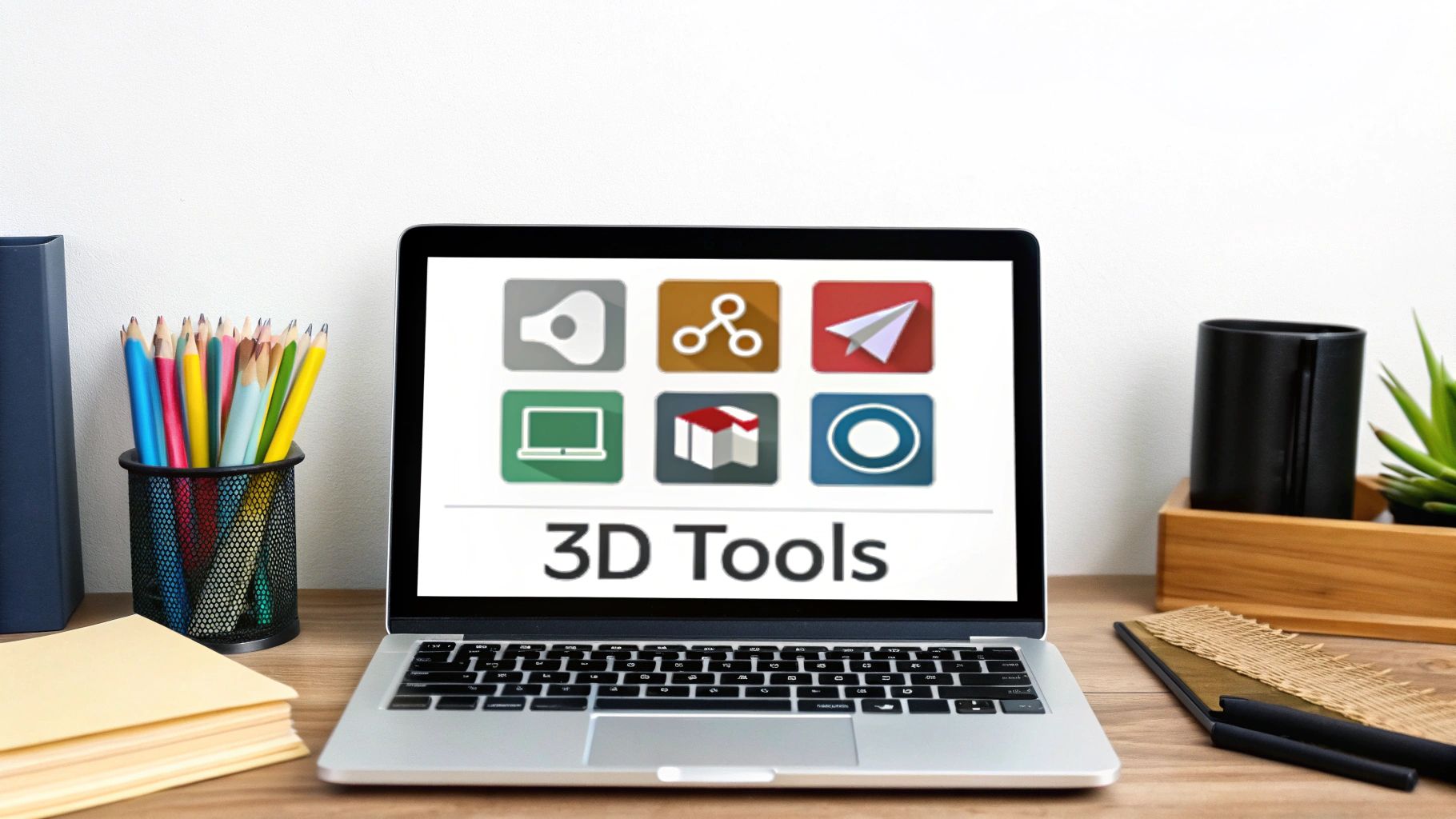
The first step is exporting the model from the AI platform and importing it into your preferred 3D software, whether that is Blender, Maya, or 3ds Max. Most text to 3d model tools export in standard formats like .OBJ or .FBX, which preserve the core geometry and basic textures. This initial import provides your first opportunity to inspect the AI-generated asset in detail.
Prepping Models for Your Pipeline
Once the model is in your software, cleanup is required. This is a non-negotiable step. AI models can have complex or flawed geometry that will cause issues later in the pipeline. Your objective is to create a clean, optimized mesh that performs well and is easy for other artists to work with.
Here is what that process typically involves:
- Fixing Geometry Errors: Look for issues like non-manifold geometry (irregular holes or impossible shapes) and intersecting faces. Most 3D programs have built-in tools that can automatically identify and repair many of these common flaws.
- Optimizing Polygon Count: AI models often have an excessively high polygon count, which can impede performance in real-time applications like games or AR. The solution is retopology—the process of creating a new, simpler mesh that conforms to the shape of the high-poly model. This retains visual detail while reducing complexity.
- Reviewing UV Maps: The UV map dictates how a 2D texture wraps around your 3D surface. AI-generated UVs can be disorganized. You will likely need to unwrap the model again to create a clean, logical UV layout that facilitates efficient texturing.
These steps are standard practice for any professional 3D artist. If you need to review the fundamentals, our guide on how to create 3D models is a valuable resource.
Ensuring Compatibility and Security
With a clean model, the next step is ensuring it is compatible with your target platform. Whether you are targeting a game engine like Unreal Engine or Unity, or an e-commerce product viewer, compatibility is essential. While .FBX is a widely supported format, engines like Unreal have specific import settings that must be configured correctly for materials and animations to transfer properly.
Beyond technical considerations, asset management is crucial for any professional team. A disorganized asset library can lead to version control problems and security vulnerabilities.
A secure, well-organized asset library is not just good practice; it is a critical component of a compliant and efficient creative pipeline. Every asset should be versioned, tagged, and stored in a central, access-controlled repository.
This means establishing a clear naming convention and folder structure from the outset. A simple convention like ProjectName_AssetType_AssetName_Version.fbx can be highly effective. This discipline ensures team members can find what they need, a clear history of each asset is maintained, and your intellectual property remains protected.
Navigating Commercial Use and Ethical Guidelines
Adopting any AI technology requires a thorough understanding of its legal and ethical landscape. When using a text to 3d model tool for commercial work, you are not just creating an asset—you are interacting with a complex system built on large datasets. This necessitates a responsible approach from day one.
The core of the issue is the training data. If an AI platform was trained on copyrighted or unlicensed assets, any models it produces could create legal risks for your organization. This is why selecting a generator that uses an ethically sourced, fully licensed dataset is a mandatory requirement for any serious project. It is the only way to mitigate potential IP disputes and ensure your work is built on a compliant foundation.
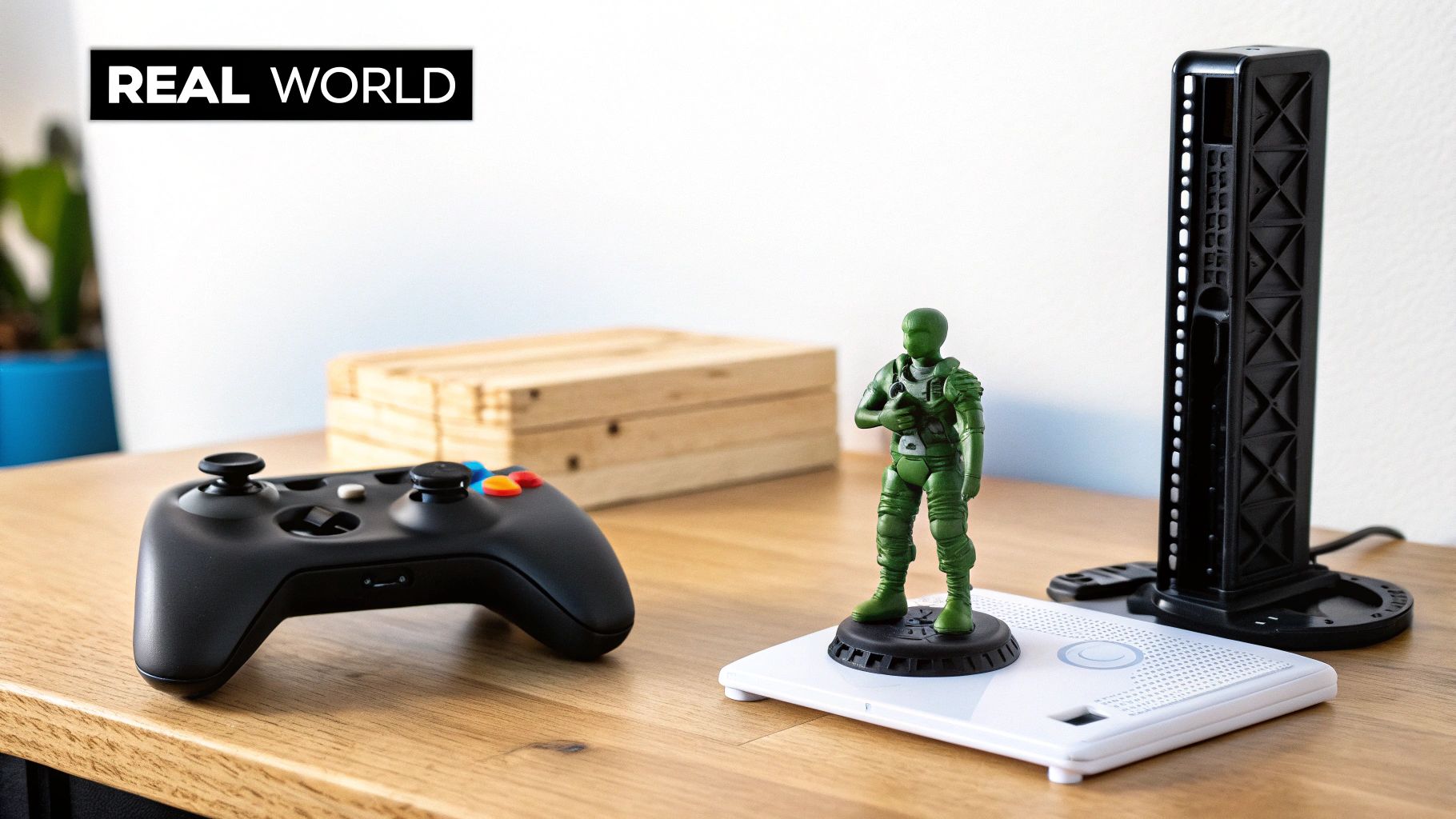
Upholding Ethical Standards in AI Creation
Beyond legal compliance, using AI responsibly is about transparency and fairness. Being open about how AI fits into your creative process builds trust with clients and your audience. It is also crucial to avoid generating content that is biased, harmful, or reinforces negative stereotypes.
While respecting the rights of others, do not neglect to protect your own work. It is prudent to research strategies for protecting intellectual property to ensure your unique creations are secure.
Addressing these issues is becoming increasingly important. Projections for text-to-3D are significant—analysts predict that within five years, these tools will be standard features in creative software suites, used by millions in gaming, e-commerce, and metaverse development. This trend underscores the need to establish clear ethical guidelines now.
The goal is to innovate without compromising on legal compliance or ethical responsibility. Your work should be both creative and credible.
Ultimately, taking a proactive stance on these issues protects your brand. By using platforms with transparent data policies and fostering a culture of ethical use, you can make text to 3d model generation a powerful—and compliant—part of your workflow. This allows you to focus on creating without undue legal or reputational risk.
Common Questions on Enterprise Text to 3D Adoption
Integrating any new technology into a large organization invariably raises important questions. When it comes to a text to 3d model generator, the primary concerns are security, quality, and budget. Teams require assurance that a new tool is robust, compliant, and adds tangible value before they will consider changing their established processes.
Let’s address the most critical issue: data security. When your team inputs proprietary product descriptions or sensitive project details, where is that data processed and stored? Any enterprise-grade platform must guarantee that your prompts and the resulting models remain in a secure, private environment. Look for providers who are transparent about data isolation and encryption, both in transit and at rest. This is non-negotiable.
Then there is the quality consideration: AI-generated assets versus the work of a skilled human artist. This is not an adversarial relationship but one of strategic collaboration.
AI is highly effective at generating foundational assets and exploring variations at a speed that is not humanly possible. Our analysis shows it can accelerate the early stages of design by up to 70%. This allows your human artists to focus on the refinement, intricate details, and final creative polish that AI cannot yet achieve.
The most effective workflows use AI for speed and scale at the front end. This frees up your most skilled artists to focus on the final, crucial 10% of creative work that defines a project’s quality.
Evaluating Cost and Return on Investment
Finally, leadership will require a financial justification. What is the cost of this technology? The pricing for text-to-3D platforms can vary, but the conversation should always center on the return on investment (ROI). This extends beyond a simple subscription fee—it encompasses the significant efficiency gains unlocked across the entire production pipeline.
To accurately calculate ROI, you need to track the right metrics:
- Reduced Modeling Time: How many hours are saved by generating initial models from a prompt instead of building them from the ground up?
- Faster Iteration Cycles: How much more quickly can your team move from concept to an approved design? This speed enables more comprehensive creative exploration.
- Asset Library Expansion: What is the value of building a large, diverse library of 3D assets that can be reused in future projects?
When you focus on these metrics, the value proposition becomes clear. A text to 3d model service is not just an expense. It is a strategic investment that makes your creative team faster, more agile, and ultimately, more productive.
Accelerate your creative pipeline with a secure, collaborative platform built for enterprise teams. Virtuall transforms your ideas into high-quality 3D models in seconds. Explore how Virtuall can optimize your workflow today.

